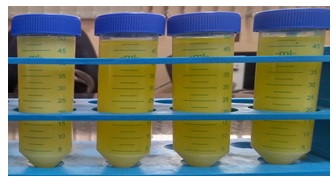Tribological Investigation of Bitter Almond Oil Containing TiO2 Nanoparticles as Additive
DOI:
https://doi.org/10.54741/asejar.1.6.4Keywords:
bitter almonds oil, four ball tester, nanoparticles, nano lubricantAbstract
In the recent years, the environment friendly lubricants have been using worldwide. Vegetable oils-based lubricants are the best substitute of the mineral and synthetic lubricant. In view of this present study concerns on tribological investigation of bitter almonds oil containing TiO2 nanoparticles and Triton X-100 as surfactant. Four different volume fractions of nanoparticles (0.01, 0.02, 0.03, and 0.04) used for nano lubricant formulation and the ratio of TiO2 nanoparticles and Triton X-100 is 2:1. The tribological investigation of formulated Bitte almond oil-based nano lubricant on Four ball tribotester using ASTM 4172B. Bitter almonds oils containing 0.02 vol. fraction nanoparticles showed minimum average wear scar diameter and coefficient of friction.
Downloads
References
Karmakar G, Ghosh P, & Sharma BK. (2017). Chemically modifying vegetable oils to prepare green lubricants. Lubricants, 5(4), 44.
J. Salimon, N. Salih, & E. Yousif. (2010). Biolubricants: raw materials, chemical modifications and environmental benefits. Eur. J. Lipid Sci. Technol., 112(5), 519–530. doi: 10.1002/ejlt.200900205.
Mandaković R., & Novina B. (2015). Trends, demands and paradoxes of lubricant micro markets such as Croatia and the surrounding countries. Croatian Society for Fuels and Lubricants.
Sevim Z Erhan, & Svajus Asadauskas. (2000). Lubricant basestocks from vegetable oils. Industrial Crops and Products, 11(2–3), 277-282.
E. Ettefaghi, et al. (2013). Preparation and thermal properties of oil-based nanofluid from multi-walled carbon nanotubes and engine oil as..., International Communications in Heat and Mass Transfer.
M. Asrul, N. W. M. Zulkifli, H. H. Masjuki, & M. A. Kalam. (2013). Tribological properties and lubricant mechanism of nanoparticle in engine oil. Procedia Eng., 68, pp. 320–325. DOI: 10.1016/j.proeng.2013.12.186.
S. Arumugam, & G. Sriram. (2014). Synthesis and characterization of rapeseed oil bio-lubricant dispersed with nano copper oxide: Its effect on wear and frictional behavior of piston ring–cylinder liner combination. Proc. Inst. Mech. Eng. Part J J. Eng. Tribol., 228(11), pp. 1308–1318. doi: 10.1177/1350650114535384.
R. Dinesh, M. J. G. Prasad, R. R. Kumar, N. J. Santharaj, J. Santhip, & A. S. A. Raaj. (2016). Investigation of tribological and thermophysical properties of engine oil containing nano additives. Mater. Today Proc., 3(1), pp. 45–53. doi: 10.1016/j.matpr.2016.01.120.
V. Cortes, & J. A. Ortega. (2019). Evaluating the rheological and tribological behaviors of coconut oil modified with nanoparticles as lubricant additives. Lubricants, 7(9), 76. doi: 10.3390/lubricants7090076.
V. Cortes, K. Sanchez, R. Gonzalez, M. Alcoutlabi, & J. A. Ortega. (2020). The performance of SiO2 and TiO2 nanoparticles as lubricant additives in sunflower oil. Lubricants, 8(1), 10. doi: 10.3390/lubricants8010010.
C. Opia, A. H. M. Kameil, Z. H. C. Daud, C. Mamah, M. I. Izmi, & A. B. A. Rahim. (2020). Tribological properties enhancement through organic carbon nanotubes as nanoparticle additives in boundary lubrication conditions. pp. 16.
J. M. Liñeira del Río, E. R. López, F. García, & J. Fernández. (2021). Tribological synergies among chemical-modified graphene oxide nanomaterials and a phosphonium ionic liquid as additives of a biolubricant. J. Mol. Liq., 336, 116885.

Published
How to Cite
Issue
Section
ARK
License
Copyright (c) 2022 Udipt, Vijay Singh

This work is licensed under a Creative Commons Attribution 4.0 International License.
Research Articles in 'Applied Science and Engineering Journal for Advanced Research' are Open Access articles published under the Creative Commons CC BY License Creative Commons Attribution 4.0 International License http://creativecommons.org/licenses/by/4.0/. This license allows you to share – copy and redistribute the material in any medium or format. Adapt – remix, transform, and build upon the material for any purpose, even commercially.










